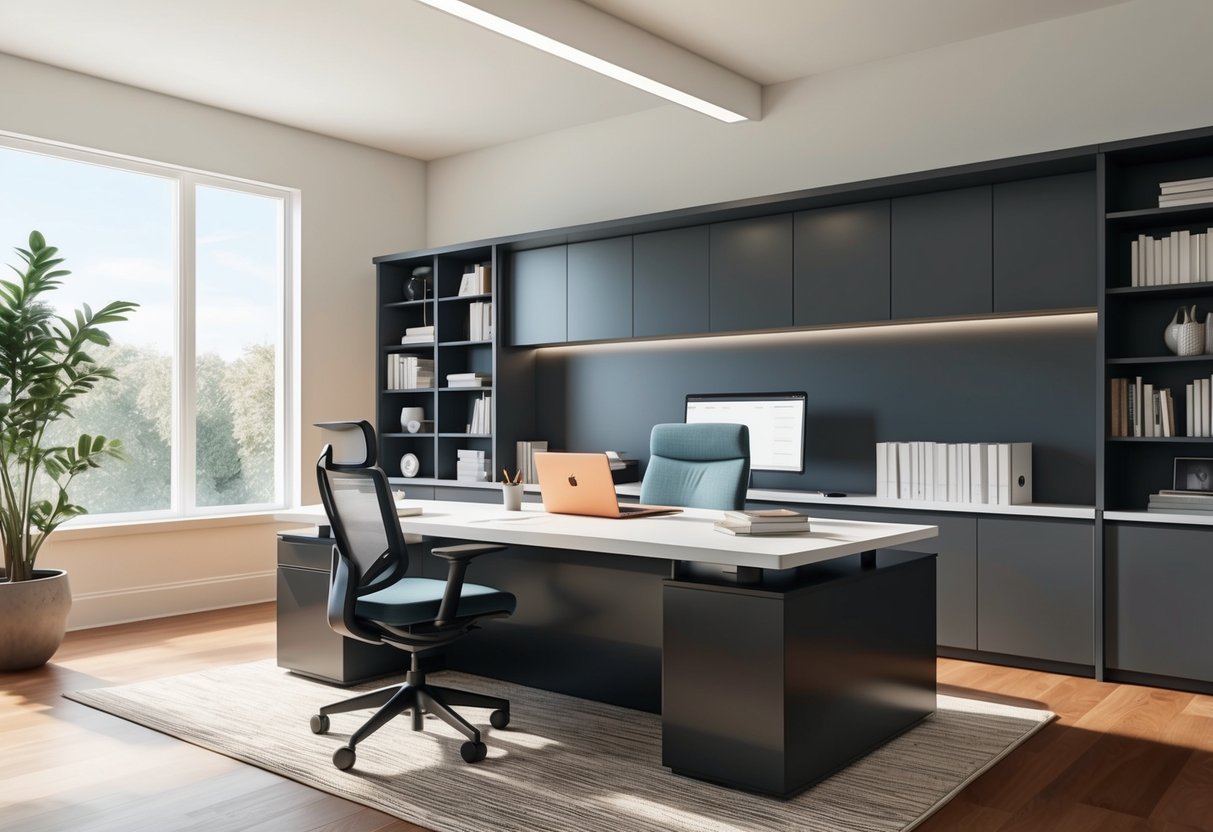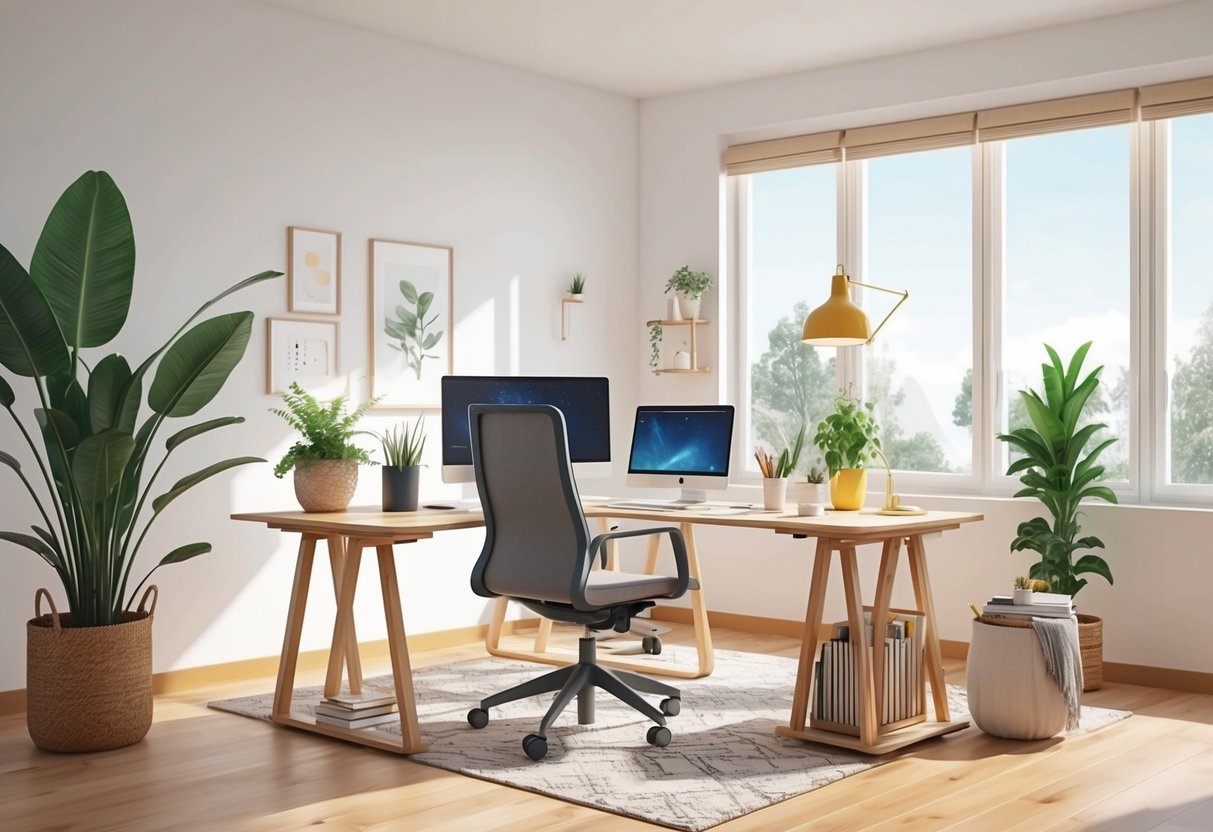
Incorporating Personal Style and Decor
A well-designed home office can significantly influence daily productivity and motivation. Integrating personal taste into the decor creates a workspace that is both inspiring and functional.
Rugs and Textiles
Selecting the right rug can establish the overall atmosphere in a home office. A patterned wool rug brings both texture and warmth, while a low-pile option supports rolling office chairs and maintains clean lines.
Soft textiles, such as throw blankets or cushions in subtle colors, can soften modern furniture and make the space more inviting. Layering textiles—think sheepskin throws on ergonomic chairs or linen curtains on windows—helps absorb sound, creating a quieter environment for concentration.
Materials like cotton or jute are durable and easy to clean, making them practical choices for workspaces with heavy foot traffic. Rugs under desks also define zones, especially in shared or multifunctional rooms, as showcased in these productive workspace ideas.
Artwork and Wall Decor
Thoughtful selection of artwork is key for creativity and mental well-being. Framed prints or canvas paintings with calming colors help reduce visual clutter, while bold graphic art can stimulate creative thinking during brainstorming sessions.
Wall shelves or gallery arrangements allow for a rotating display of inspiring images, degrees, or certificates. To keep visual interest without distraction, use a mix of large-scale art and smaller prints positioned above and behind the main workstation.
Incorporating functional wall decor, such as magnetic boards or wire grids, merges decoration with organization, helping streamline workflow by keeping reminders, calendars, and to-do lists within easy reach. Accent pieces like clocks or sculptural wall hangings provide additional dimension and style.
Personal Touches for Motivation
Motivational quotes, vision boards, or framed family photos personalize the office, making it distinct from more generic workspaces. Items that hold sentimental value—awards, travel souvenirs, or heirlooms—can boost both morale and commitment.
Arranging personal touches within eyesight of the primary work area ensures they serve as recurring reminders of personal goals and achievements. Plants and succulents add a touch of nature, supporting well-being and oxygen flow.
Using unique desk accessories, such as custom calendars or branded notebooks, maintains a professional yet personalized environment. This directly supports focus and motivation, as demonstrated by these stylish workspace ideas.
Creating a Healthy and Comfortable Workspace

A well-designed workspace enhances comfort and supports employee well-being by paying careful attention to air quality, noise control, and design elements drawn from nature. Thoughtful choices in these areas result in a home office where focus and productivity come naturally.
Indoor Plants and Natural Elements
Incorporating indoor plants is one of the most effective ways to bring nature-inspired design into a workspace. Plants like pothos, snake plant, and peace lily require minimal maintenance and thrive indoors, improving both the visual appeal and atmosphere.
These green additions not only add color and texture but also play a role in reducing stress and boosting psychological well-being. Natural elements such as wooden furniture, stone accents, and natural light can contribute to a more inviting atmosphere.
Large windows or bright LED bulbs with natural light temperature are known to foster a sense of openness. Arranging relocated pieces of natural decor—like a wood desktop or bamboo shelves—can enhance comfort and maintain a visual connection to nature.
A blend of greenery and nature-inspired materials promotes a productive environment by making the workspace feel less isolated and more calming. This approach is widely recommended in modern office design concepts for employee well-being.
Air Quality Improvement
Healthy air quality is crucial for focused and comfortable work. The use of indoor plants can slightly improve air purification, but mechanical aids like HEPA air purifiers offer targeted filtration of allergens, dust, and airborne particles.
Opening windows for even short periods increases airflow and reduces carbon dioxide buildup, which can otherwise cause drowsiness or headaches. Keeping surfaces clean and clutter-free minimizes dust and mold growth, so regular cleaning is essential.
For an extra layer of comfort, maintain humidity levels between 30% to 50%. This can be achieved with a small humidifier or dehumidifier, depending on your local climate.
Materials free from strong chemicals—such as low-VOC paints and nontoxic finishes on desks or chairs—further support healthy breathing. This contributes long-term to employee well-being, comfort, and sustained focus throughout the workday.
Noise Reduction Techniques
Noise can negatively impact concentration and increase stress. Start by identifying outside noise sources, such as traffic or neighbors, and block or dampen them with thick curtains, weather stripping, or double-glazed windows.
Soft furnishings such as area rugs, upholstered chairs, and fabric wall panels also absorb sound and prevent echoes in a home office. For those who share their space, white noise machines or background music can mask unpredictable household sounds.
Some professionals wear noise-canceling headphones for extra isolation during calls or focused tasks. A layout that places the desk further from noisy entryways can also reduce disruptions.
Designing the space with strategic furniture placement and soft surfaces supports a calmer, more productive atmosphere. This makes it easier to maintain focus even in busier homes.